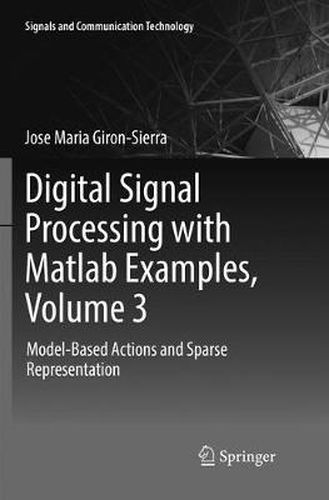Readings Newsletter
Become a Readings Member to make your shopping experience even easier.
Sign in or sign up for free!
You’re not far away from qualifying for FREE standard shipping within Australia
You’ve qualified for FREE standard shipping within Australia
The cart is loading…






This title is printed to order. This book may have been self-published. If so, we cannot guarantee the quality of the content. In the main most books will have gone through the editing process however some may not. We therefore suggest that you be aware of this before ordering this book. If in doubt check either the author or publisher’s details as we are unable to accept any returns unless they are faulty. Please contact us if you have any questions.
This is the third volume in a trilogy on modern Signal Processing. The three books provide a concise exposition of signal processing topics, and a guide to support individual practical exploration based on MATLAB programs.
This book includes MATLAB codes to illustrate each of the main steps of the theory, offering a self-contained guide suitable for independent study. The code is embedded in the text, helping readers to put into practice the ideas and methods discussed.
The book primarily focuses on filter banks, wavelets, and images. While the Fourier transform is adequate for periodic signals, wavelets are more suitable for other cases, such as short-duration signals: bursts, spikes, tweets, lung sounds, etc. Both Fourier and wavelet transforms decompose signals into components. Further, both are also invertible, so the original signals can be recovered from their components. Compressed sensing has emerged as a promising idea. One of the intended applications is networked devices or sensors, which are now becoming a reality; accordingly, this topic is also addressed. A selection of experiments that demonstrate image denoising applications are also included. In the interest of reader-friendliness, the longer programs have been grouped in an appendix; further, a second appendix on optimization has been added to supplement the content of the last chapter.
$9.00 standard shipping within Australia
FREE standard shipping within Australia for orders over $100.00
Express & International shipping calculated at checkout
This title is printed to order. This book may have been self-published. If so, we cannot guarantee the quality of the content. In the main most books will have gone through the editing process however some may not. We therefore suggest that you be aware of this before ordering this book. If in doubt check either the author or publisher’s details as we are unable to accept any returns unless they are faulty. Please contact us if you have any questions.
This is the third volume in a trilogy on modern Signal Processing. The three books provide a concise exposition of signal processing topics, and a guide to support individual practical exploration based on MATLAB programs.
This book includes MATLAB codes to illustrate each of the main steps of the theory, offering a self-contained guide suitable for independent study. The code is embedded in the text, helping readers to put into practice the ideas and methods discussed.
The book primarily focuses on filter banks, wavelets, and images. While the Fourier transform is adequate for periodic signals, wavelets are more suitable for other cases, such as short-duration signals: bursts, spikes, tweets, lung sounds, etc. Both Fourier and wavelet transforms decompose signals into components. Further, both are also invertible, so the original signals can be recovered from their components. Compressed sensing has emerged as a promising idea. One of the intended applications is networked devices or sensors, which are now becoming a reality; accordingly, this topic is also addressed. A selection of experiments that demonstrate image denoising applications are also included. In the interest of reader-friendliness, the longer programs have been grouped in an appendix; further, a second appendix on optimization has been added to supplement the content of the last chapter.